Gold Note Mediterraneo Turntable, B-7 Ceramic Tonearm, and Donatello Gold MC Cartridge
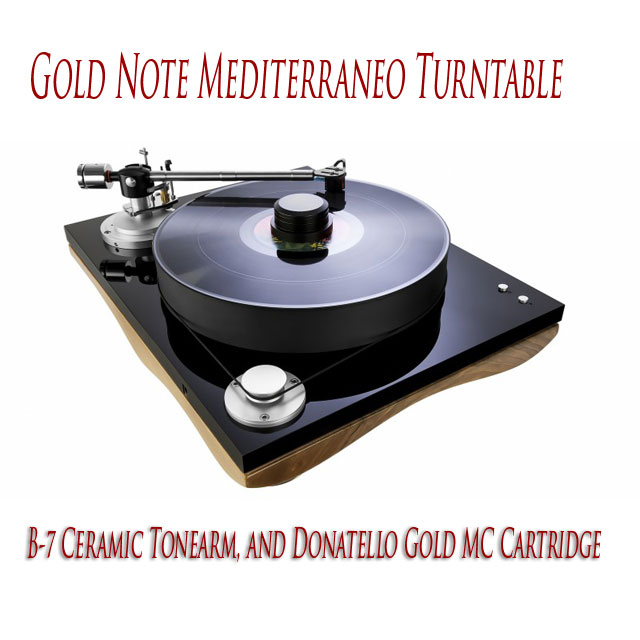
 The Silent System
The Silent System
I’m writing about a turntable in a silent room on a Sunday morning, the victim of a suicidal ½ amp fast-blow fuse – the one size of three in my amplifier that I don’t have on hand. Alas. At least the turntable – the Gold Note Mediterraneo – is very pretty to look at. It sounds good, too, but that’ll have to wait until a get my amp running again.
But First, An Audiophile Love Story and Some Old Friends
Janet and Bayard met while they were both working at Purdue Audio in Montclair, NJ in the mid-1950s, at the time the local McIntosh dealer, where he was a buyer and she was selling records with a newly minted music degree from Smith College. They married, had four children, and lived in Montclair for forty years or so. Both were true music connoisseurs (although Janet might have found the very word pretentious), and their children are all either professional musicians or remain involved in music in some way to this day.
When I was a kid in the 1970s Janet and my Mother were good friends through the choir they both sang in at the First Congregational Church on South Fullerton Avenue, an accomplished bunch of musicians led by an even more accomplished organist; a group of people whose association lasted for decades and continues to this day. In 1969, Janet threw the baby shower for my mother, which – having arrived early – I attended in person.
 Bayard was the first person I ever met who could credibly claim the title of “audiophile,” although it’s unlikely he would have applied it to himself. He had a big McIntosh MC 275 tube amp and matching preamp fed by a Thorens turntable. I had no idea what they were when I was seven, but those glowing KT88s were cool and a bit dangerous looking. Bayard was an engineer with a wicked sense of humor who at one point was scheming how to turn the living room wall cavities into giant speakers (Janet shot that down), but his crowning achievement in my young eyes was finding his dogs in the dark. They had three dark grey Scotties who were impossible to see at night, so he built battery operated light stalks attached to their collars. You couldn’t see the dogs, but you could see the little dots of light bouncing around the yard, color coded so he could tell which dog was which. He also used to periodically show up at church with a giant reel-to-reel tape recorder and microphones if the organist or choir was performing something special.
Bayard was the first person I ever met who could credibly claim the title of “audiophile,” although it’s unlikely he would have applied it to himself. He had a big McIntosh MC 275 tube amp and matching preamp fed by a Thorens turntable. I had no idea what they were when I was seven, but those glowing KT88s were cool and a bit dangerous looking. Bayard was an engineer with a wicked sense of humor who at one point was scheming how to turn the living room wall cavities into giant speakers (Janet shot that down), but his crowning achievement in my young eyes was finding his dogs in the dark. They had three dark grey Scotties who were impossible to see at night, so he built battery operated light stalks attached to their collars. You couldn’t see the dogs, but you could see the little dots of light bouncing around the yard, color coded so he could tell which dog was which. He also used to periodically show up at church with a giant reel-to-reel tape recorder and microphones if the organist or choir was performing something special.
This drove the minister crazy, by the way, as he thought the focus should always be on religion, not music (they always do). There was a bit of a parallel fiefdom in the loft and the members of the choir were an irreverent lot.
Fast-forward forty years and unfortunately Janet, followed by Bayard, had both passed away. I’d been corresponding with their kids for a while when one of them mentioned that they still had Bayard’s records, classical titles collected over decades starting in the early 1950s. So on a Friday morning in April I drove to North Carolina where I shared a little too much wine with three of the Janet and Bayard’s children – two of whom baby sat for me – who now achieve the status of dear old friends the way only people you’ve known your entire life can be, even though we hadn’t seen each other in twenty-five years. I drove home with a decent sized collection of well-cared-for classical records, tons of new music to explore, and – this is important to me as a jazz fan – not a single version of “Stella By Starlight” in the lot.
I’ve barely scratched the surface of this collection, but every time I feel the urge to buy a new record, I stop myself, go flipping through Bayard’s collection, and discover some great new-to-me music. I love knowing where the records came from, knowing the man who collected them, and his family. It’s more personal than simply digging through crates in a record store. If my Dad’s over and we’re listening to music I find myself announcing records with, “This is another one of Bayard’s.”
My warmest regards to the family and thank you.
One More Wheel and I’d Have a Car
 I have three working turntables in my house, two of which are hooked up at any given time, and I’d add another one if the right opportunity presented itself. Some people collect antiques, some people like baseball cards, I like turntables (and records, of course). It’s not nearly as crazy as – for example – collecting cats and having twenty-three running around the house, which is clearly some sort of deviant behavioral disorder.
I have three working turntables in my house, two of which are hooked up at any given time, and I’d add another one if the right opportunity presented itself. Some people collect antiques, some people like baseball cards, I like turntables (and records, of course). It’s not nearly as crazy as – for example – collecting cats and having twenty-three running around the house, which is clearly some sort of deviant behavioral disorder.
Although all three tables do the same thing functionally, aesthetically they couldn’t be more different. The Rek-O-Kut T12h has the design sensibility of a WWII era truck, cast aluminum with crinkle finish grey paint; the Sota Nova VI, while lovely, is unadorned and minimalist in its mid-century modern way, with only the wooden case to warm the design; the Mk I Technics SL-1200, with its naked aluminum body, exposed strobe pattern, and direct-drive, is 1970s Japanese high-tech – functional metal all the way. All three of them are very good turntables, but none of them incorporate what most people would think of as especially beautiful design. Even the massive, seven-inch-tall crimson plinth holding the Rek-O-Kut, while dramatic, was a case of form following function: the enormous motor hangs six inches under the top plate so the depth of the plinth was dictated by the need to fully encase it. I just happened to stain it bright red.
With the arrival of the Gold Note Mediterraneo turntable, something dramatically different has arrived at my doorstep. Where my turntables are studies in function-driven engineering, the Mediterraneo has added a refreshing dash of aesthetic flair that includes curves beyond the simple circumference of the platter. You really can describe it as pretty.
It sounds good, too.
Oh, and it comes with a dust cover. Halleluiah!
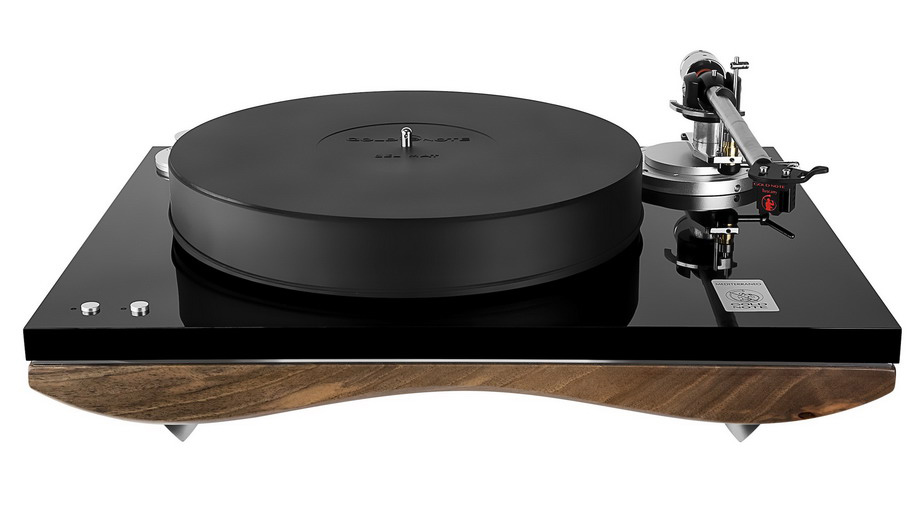
The Gold Note Mediterraneo Turntable
The Mediterraneo turntable, accompanied by the B-7 ceramic tonearm, is the top of Gold Note’s range of five disc-spinners. The surface of its plinth is an inch-thick slab of highly polished black acrylic affixed to a solid walnut base with a thin layer of aluminum sandwiched between them. It’s the walnut base that makes the table unusually attractive. Not simply a slab of hardwood, it’s been carved and polished into an undulating surface that looks a little like inverted ocean waves. The milling and finish on the wood is precise and immaculate, and the acrylic is flawlessly reflective. Gold Note claims positive resonance properties for the wood, in addition to its aesthetic value. Three adjustable spiked feet are used to level the table, with accompanying pucks to protect furniture. The platter, also black, is approximately three inches thick and made of something called Sustarin, a matt-finish polymer that is said to be very rigid and possess excellent damping properties. The platter is topped with a black felt mat. An aluminum record weight is also included.
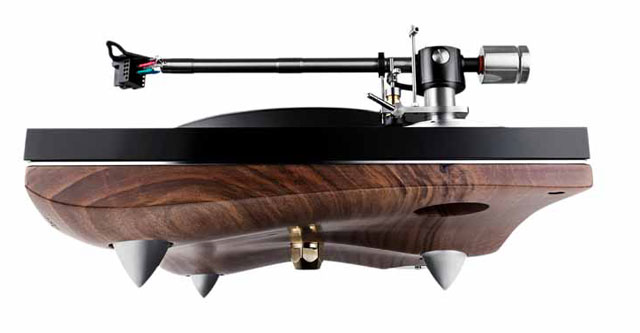
Drive is provided by a high-torque Swiss synchronous motor, operated by Gold Note’s “Quadral-Core” micro-controller which they claim re-shapes AC waves to minimize vibrations while still allowing a high-torque delivery. Two buttons on the top plate – one for 33 and one for 45 – start and stop the motor. An O-ring type belt connects the motor pulley to the platter. As advertised, there is plenty of torque here, enough to make the belt chirp against the pulley every time you start the motor.
The main bearing features several high-quality materials including a hardened chromed steel shaft, a polished bronze well, and a tungsten ball bearing. It may be pretty on the outside, but the Mediterraneo’s got it where it counts. Properly leveled and spun by hand the platter spins for a long, long time, a very nice, exceptionally smooth bit of engineering.
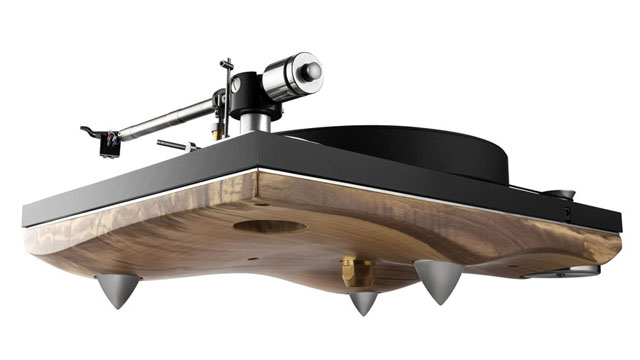
Setting up the Mediterraneo is relatively simple, as the arm was already mounted. As an un-sprung table, a good solid shelf or piece of furniture is highly recommended and my Mapleshade equipment rack provided good support. Level the plinth on the three pointed feet – I used the supplied disks so as not to scratch my furniture, but somehow scratched it anyway – lower the platter onto the exposed bearing, then screw in the spindle nub from the top, locking it all together. Connect the supplied external power supply and hit the start button.
The B-7 Ceramic Tonearm
The B-7 is a straight gimbaled arm with a generously sized headshell. It features four German ceramic ball bearings at the pivot points, an effective length of 242mm, and Azimuth adjustment by way of two hex head bolts that can be loosened at the headshell. The counterweights – there are two of different sizes – are stainless steel, the pivot yoke and arm-tube attachment are milled aluminum, and the arm tube itself appears to be either stainless steel or aluminum. Anti-skate is provided by a small weight on a string, a time-tested method going back the original SME 3009/12 tonearms designed in the 1950s. The package also came with Gold Note’s own tonearm cable, with an XLR connection to the arm and RCA jacks and a forked ground wire at the other end.
I mentioned the generously sized, frying pan shaped headshell. The size, as well as the greater than usual distance from the cartridge to the point where the lead wires exit the arm tube, made it exceptionally easy to install a cartridge, with plenty of room for fat fingers and enough metal to provide good purchase for making fine adjustments during setup. Using the Dr. Fleikert’s protractor, its proportions made it one of the easiest arms I’ve ever had the pleasure of setting up. I only used the larger of the two counterweights, though.
A Nice Bundle
 As best I can tell, all Gold Note tables are sold with an arm already installed, so that’s how I reviewed the Mediterraneo. I would have liked to have tried the Mediterraneo with my own arm, and for that matter I would like to have installed this arm in my own turntable, to evaluate each separately with known equipment. Unfortunately, this would have required getting new armboards drilled for both tables, which would not have been practical.
As best I can tell, all Gold Note tables are sold with an arm already installed, so that’s how I reviewed the Mediterraneo. I would have liked to have tried the Mediterraneo with my own arm, and for that matter I would like to have installed this arm in my own turntable, to evaluate each separately with known equipment. Unfortunately, this would have required getting new armboards drilled for both tables, which would not have been practical.
The Mediterraneo also came with a Gold Note Donatello Gold moving coil cartridge ($1,070.00) already installed, which I promptly removed in favor of my own Lyra Delos so I could review the table with a familiar pickup. The Donatello is not included with the price of the turntable but was installed by the distributor for this review. I’ll cover the cartridge separately, installed on my own turntable, in another review.
The Reference
My primary stereo table for over a decade now has been one of two SOTAs; first a Star-Sapphire, and currently the new Nova VI. Both have a similar sound, with the Nova enunciating those traits more clearly. In general, using the Jelco-750 DB arm and the same Lyra Delos cartridge, the Nova is a very detailed, transparent turntable, with a large soundstage and good representation of depth. Images are clear and precise.
What Nova VI doesn’t do is gloss over poor pressings or worn recordings. If there’s something on the record that doesn’t sound good, whether production related or if the record has just been played a few too many times, you’ll be able to hear it. This can be frustrating if I want to listen to good music that suffers from either of those issues – and there are plenty of great records that weren’t pressed with the utmost attention to quality control – but when the media is good the combination is terrific. It’s these qualities that make the Nova VI a good reviewer’s tool. The table reveals everything I need to hear from media and from equipment downstream to make accurate evaluations.
The Challenger
But not everyone needs those specific qualities. People using their source components to evaluate subtle tonal differences in cables are at best a small subset of listeners. Most just want their music to – first and foremost – sound beautiful and convey emotional qualities. They want to listen to their music, not their turntable, and the Gold Note Mediterraneo would be an excellent candidate for that purpose. It’s a real sweetie, particularly on classical and jazz recordings. Some of its qualities offer parity with my SOTA, but there are some significant differences, too.
The Similarities
To start, the Mediterraneo/B-7 combination is exceptionally quiet, both in its operation and in its rejection of surface noise, at least with my cartridge. Background noise recedes dramatically, greatly reducing one of the bugbears of vinyl playback. It won’t fix records that are badly worn, or eliminate recorded tape hiss, but on reasonably fresh, properly cleaned records it establishes a quiet stage, allowing the listener to place more focus on the performance, a good starting baseline.
The Mediterraneo also throws a very large and unified soundstage. This is a very natural sounding turntable with chamber musicians or entire orchestras spread across the room to the speakers and beyond, scaled properly and with a realistic sense of space. There were no gaps or any crowding around the speakers unless the album was recorded that way. Stage depth is reasonably good, and the entire image is consistent, with no hot spots or recessive anomalies.
The Mediterraneo also offers very good speed stability. I did not hear a single incident of anything that could have been identified as an audible fluctuation.
In these respects, it performs similarly to the SOTA.
The Differences
The Metiterraneo delivers a softer, easy going sound with smooth treble and slightly less focused bass that my own turntable. It’s a much warmer sounding than my SOTA. Matching its aesthetics, the sound produced by this turntable could easily be described as ‘pretty.’ Another note I took was ‘Laid back.’ There were fewer hard edges and easier musical momentum.
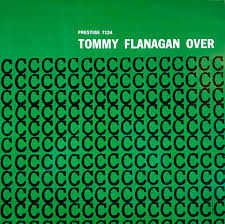 The treble is very sweet and satisfyingly extended, if not quite as mile high as my own turntable. This isn’t to suggest that the treble is rolled off – it’s not – it’s just not as etched in space as it is on the SOTA. In this respect the Mediterraneo takes a small advantage for enjoyable listening. It may not have as much ultimate extension, but it still has plenty, and it’s more pleasant to listen to on some recordings where the Nova sometimes seems to dwell on flaws.
The treble is very sweet and satisfyingly extended, if not quite as mile high as my own turntable. This isn’t to suggest that the treble is rolled off – it’s not – it’s just not as etched in space as it is on the SOTA. In this respect the Mediterraneo takes a small advantage for enjoyable listening. It may not have as much ultimate extension, but it still has plenty, and it’s more pleasant to listen to on some recordings where the Nova sometimes seems to dwell on flaws.
Midrange has a lovely flowing liquidity, reinforcing this turntable’s sense of ease. Tommy Flanagan’s classic monaural trio album Overseas (Analog Productions APRJ 7134-A, Prestige PRLP 7134) is relaxed, but with plenty of detailed reverberations and big round notes from the piano. Elvin Jones brushed drums have dynamic snap and pop. The Mediterraneo makes it abundantly clear that this is late night jazz, smooth as aged scotch.
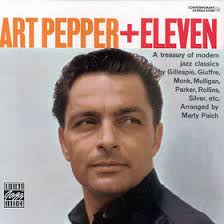 Switching to Stereo, a 1994 test pressing of Analogue Productions reissue of Art Pepper + Eleven (APJ 017, 1994) captures a large ensemble horn section as well as almost any record I know. The key here is the texture. Baritone saxes and trombones bite with tenacious grip, and everyone is clear in the massed unison lines of Bird’s “Anthropology”. The Mediterraneo makes this record sound rich, even plush. It’s gorgeous (I should be writing copy for yogurt ads, right?).
Switching to Stereo, a 1994 test pressing of Analogue Productions reissue of Art Pepper + Eleven (APJ 017, 1994) captures a large ensemble horn section as well as almost any record I know. The key here is the texture. Baritone saxes and trombones bite with tenacious grip, and everyone is clear in the massed unison lines of Bird’s “Anthropology”. The Mediterraneo makes this record sound rich, even plush. It’s gorgeous (I should be writing copy for yogurt ads, right?).
Individual plucked basses have good tonality – woody and deep – though without quite as much punch as I’m accustomed to. There’s slight softness that – on some recordings – leaves the deepest low notes to seem a bit over-ripe. This is fine on most records, but occasionally excessive on others. It makes small combo jazz records sound a little fuller and more fleshed-out but can sometimes leave the mix feeling a little out of balance; a bit too bass heavy. Some records with massed bowed double basses felt a hair blurred at the bottom, but just a bit and not universally. On the aforementioned Tommy Flanagan record, Wilbur Little’s bass sounds proportional, appropriately tight and well defined. More importantly, the bass blended well with the character of the overall presentation. It wasn’t distracting.
Overall, this turntable seems voiced more towards musical fulfillment rather than ultimate hi-fi resolution, and that’s a compliment. It’s softer than my own table – if just a little – but highly organic sounding. At no time did I feel as though I were straining to hear any of the details. Most of the spectrum had excellent dynamics: snap from drum strikes and brass bite. It’s an easy turntable to just sit back and listen to and indeed I found myself focusing more the music and less on the gear. Of course, my job here is to listen to gear, but that can get tiresome occasionally, so the Mediterraneo was a nice change of pace: just kicking back and enjoying some records.
A Classical Interlude
As good as it is with jazz recordings, I really enjoyed the Mediterraneo with well-recorded classical music. With the right records, the soundstage sweeps across the room, the sections of the orchestra clearly delineated, soloists large in the mix, and terrific propulsion of time and motion.
I’ve been listening to an Arkiv Produktion recording of J.S. Bach’s Brandenburgishe Konzerte (or the Brandenburg Concertos for the rest of us), from a 1963 stereo box set (5 albums, Arkiv SKL 122/126, 1963). These Arkiv records were definitely pressed with the audiophile in mind: slightly heavier vinyl presented as a research series on European music that come with sheets of technical recording data, often initialed in pen on a quality control sticker on the plain yellow covers. Whoever produced this series was clearly paying attention to the details. On concerto #1 in F-major, the solo oboe is clearly a reed instrument, but exceptionally smooth, without any unpleasant buzz. The solo violin is a pleading cry. The tutti passages make it clear that this performance is an appropriately smallish orchestra with every instrument clear and in its place. The whole thing just drew me in, a most enjoyable musical morning.
 Better still, a 1961 Deutsche Grammophon pressing of George Szell conducting cellist Pierre Fournier and the Berlin Philharmonic on Dvorak’s Cello Cocerto In B Minor, Op. 104 (Deutsche Grammophon SLPM 138 755, 1961). I didn’t get far into the first Allegro movement when Fournier stopped me cold: emphatic and emotionally laden – his performance simply demanded I abandon anything else I was futzing around with to just listen. The contrast of the sorrowful cello against the orchestra is irresistible, the performance so powerful that it commanded my attention, twice all the way through, as a matter of fact. Plus, as a recording, this one is spectacular. Fournier is writ large, front and center. In passages where the basses are featured, the density and weight as realistic as I’ve heard in my house. Piccolo and horn accents are deep in the stage, while the strings are circled around the conductor’s podium in the center. Absolutely among the best classical vinyl experiences I’ve had. This record is engaging, detailed, and impressive sounding on my own turntable. It was gorgeous on the Mediterraneo.
Better still, a 1961 Deutsche Grammophon pressing of George Szell conducting cellist Pierre Fournier and the Berlin Philharmonic on Dvorak’s Cello Cocerto In B Minor, Op. 104 (Deutsche Grammophon SLPM 138 755, 1961). I didn’t get far into the first Allegro movement when Fournier stopped me cold: emphatic and emotionally laden – his performance simply demanded I abandon anything else I was futzing around with to just listen. The contrast of the sorrowful cello against the orchestra is irresistible, the performance so powerful that it commanded my attention, twice all the way through, as a matter of fact. Plus, as a recording, this one is spectacular. Fournier is writ large, front and center. In passages where the basses are featured, the density and weight as realistic as I’ve heard in my house. Piccolo and horn accents are deep in the stage, while the strings are circled around the conductor’s podium in the center. Absolutely among the best classical vinyl experiences I’ve had. This record is engaging, detailed, and impressive sounding on my own turntable. It was gorgeous on the Mediterraneo.
Hi! I’m Mat!
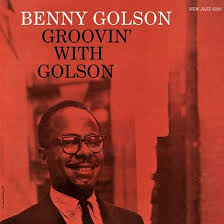 It’s no secret that the sound of a turntable can be adjusted a bit by changing the material of the platter matt. In addition to the felt mat that came with the Mediterraneo I had two other options: the Thorens rubberized cork mat that I use on my Rek-O-Kut, and no mat at all. Spinning the excellent Analogue Productions reissue of Benny Golson’s Grovin’ With Golson, the bass was the softest with the stock matt, tightened a bit with the cork and was tighter still with no matt at all. This isn’t to say the bass was diffuse or slovenly with the stock mat – It was still palpable and audibly defined – it just wasn’t quite as firm as the other two options.
It’s no secret that the sound of a turntable can be adjusted a bit by changing the material of the platter matt. In addition to the felt mat that came with the Mediterraneo I had two other options: the Thorens rubberized cork mat that I use on my Rek-O-Kut, and no mat at all. Spinning the excellent Analogue Productions reissue of Benny Golson’s Grovin’ With Golson, the bass was the softest with the stock matt, tightened a bit with the cork and was tighter still with no matt at all. This isn’t to say the bass was diffuse or slovenly with the stock mat – It was still palpable and audibly defined – it just wasn’t quite as firm as the other two options.
However, getting that modestly tighter bass required some tradeoffs that I’m not sure I’d want to make. The treble was sweetest and smoothest with the stock matt. The cork split the difference and going bareback offered a hair more overall detail but also left the treble a little hard and rigid sounding. In my system the cork seemed the most neutral, but overall, I preferred the stock matt. The tradeoff in the bass was relatively minor and that sweet, sweet treble seems like such an essential character of this table that it’d be a shame to do anything to diminish it. Once I’d done this little experiment, I stuck with the stock mat for the remainder of the review.
Of course, all those impressions could change with a different cartridge, or other components downstream, and who knows, in different circumstances I might have made a different choice. It’s always good to have options. Your results may vary.
Conclusion
I once read a review of a pair of Harbeth speakers where the writer stated something to the effect of “All considerations of reviewing tossed aside, if I just needed one pair of speakers that I could live with forever, that simply made music sound beautiful, the Harbeths would be it.” Swap out “Harbeth” for “Gold Note Mediterraneo” and that could be the review. I couldn’t state it any better. More so than any other component I’ve ever had in my systems, the Mediterraneo makes music sound beautiful. It wasn’t the be-all, end-all of neutrality, but who cares? It was, without a doubt, one of the most enjoyable turntables I’ve ever listened to.
If you’re looking for a substantial, beautiful, and beautifully built turntable and arm combination that makes lovely music, the Gold Note Mediterraneo should be high on your audition list. I split a few hairs with the bass, but overall, I found its sonic character to be engaging, detailed, and very, very pleasurable to listen to. I spent more time with the Mediterraneo listening to and enjoying music than critiquing it as a piece of equipment, and that’s the highest compliment I can offer.


greg simmons
Specifications:
Dimensions: 470mm W, 210mm H, 360mm D.
Weight: 20kg
Wow & Flutter: 0.1%
Rumble: -80dB
Speed: 33.33 and 45 rpm ±0.1%
Speed Changing: electronic with fine pitch control
Transmission: 70 shore rectified poly-vinyl belt
Motor: 12 Volt High-Torque synchronous, external power supply
Platter: Ultra Dead Design Sustarin, 45mm (it really does say “Ultra-Dead” in the lit)
Platter Spindle: Split-Spindle
Platter Bearing: Tungsten 5mm ball bearing with adjustable brass seat in polished bronze.
Address:
Gold Note
Via Virginio 158
Montespertoli (Firenze)
Italy – 50025
Associated Equipment:
Digital Front End
Cambridge CXC CD transport
Cambridge 840C CD player (Still lonely and looking for love)
Analog Front End
SOTA Nova VI turntable
Rek-O-Kut T12h turntable
Techniques 1200 Mk 1 turntable
Jelco 9” SA-750 DB toneam
Audioquest PT6 tonearm
Karmadon 12” viscous damped unipivot tonearm
Lyra Delos cartridge
Audio-Technica OC/9-III cartridge
Audio-Technica AT33Sa cartridge
Miyajima Spirit Mono cartridge
Amplification
Cary SLP-98P preamp w/ phono stage
Cary CAD 280 SA V12R power amplifier
Aurorasound SP-03H stepup transformer
Lyric Audio PS-10 MC/MM phono stage
Loudspeakers
Verity Audio Fidelity Encore
Magnepan MG-IIA
Cabling
Audio Quest Copperheads
Zentara Reference ICs
Zentara Reference Speaker Cables
Nordost Blue Heaven ICs
Cullen power cables
AudioQuest NRG-Z3 power cables
MIT Z-Cable power cords
Accessories
AudioQuest Niagara 1200 power conditioner
Tice Box power conditioner
Nordost Sort Kones AC vibration dampers
Mapleshade Audio Rack
One thought on "Gold Note Mediterraneo Turntable, B-7 Ceramic Tonearm, and Donatello Gold MC Cartridge"
Leave a Reply
Stereo Times Masthead
Publisher/Founder
Clement Perry
Editor
Dave Thomas
Senior Editors
Frank Alles, Mike Girardi, Russell Lichter, Terry London, Moreno Mitchell, Paul Szabady, Bill Wells, Mike Wright, and Stephen Yan,
Current Contributors
David Abramson, Tim Barrall, Dave Allison, Ron Cook, Lewis Dardick, John Hoffman, Dan Secula, Don Shaulis, Greg Simmons, Eric Teh, Greg Voth, Richard Willie, Ed Van Winkle, and Rob Dockery
Site Management Clement Perry
Ad Designer: Martin Perry



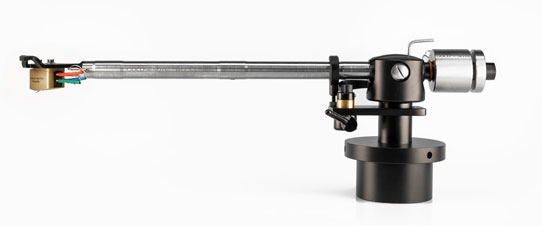
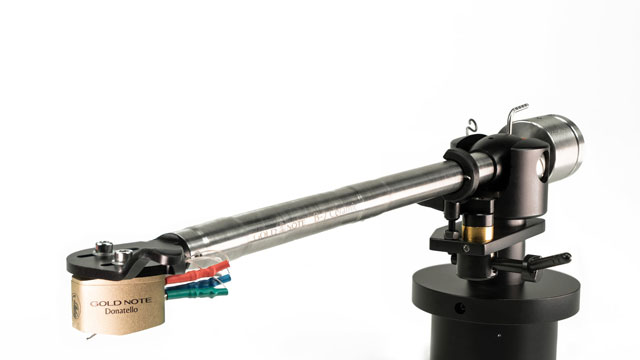



Great description of this turntable and sound. I have it and thought the same thing. It seemed to me to get everything just right so I was able to just listen and enjoy versus thinking about the equipment.